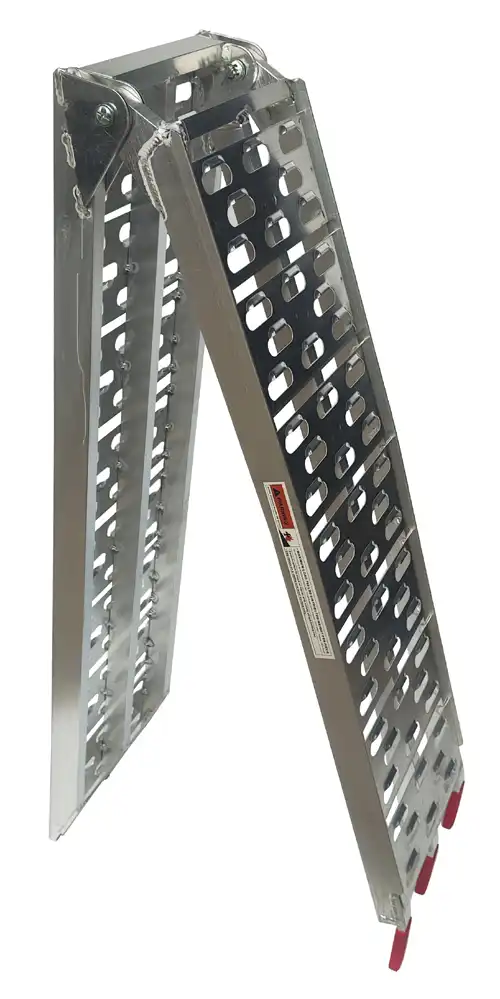Understanding Motorcycle Ramp Dimensions
Length Matters: Choosing the Right Ramp Length
The length of your motorcycle loading ramp plays a pivotal role in creating a safe and manageable incline. A longer ramp translates to a gentler slope, which is particularly beneficial when dealing with low-clearance bikes or elevated loading surfaces. For standard pickup trucks or trailers, a 7-foot ramp often suffices. However, if you're working with a higher vehicle or a motorcycle with limited ground clearance, you might want to consider an 8-foot or even 10-foot ramp.
It's essential to calculate the angle of incline your ramp will create. A steeper angle increases the risk of the bike's undercarriage scraping the ramp or, worse, the rider losing control during loading. As a rule of thumb, aim for an incline angle of 15 degrees or less. This can be achieved by ensuring your ramp length is at least four times the height difference between the ground and your loading surface.
Width Considerations: Balancing Stability and Portability
While length affects the slope, width influences stability during the loading process. Most motorcycle loading ramps range from 12 to 14 inches in width, which is adequate for many bikes. However, if you're dealing with a heavier motorcycle or if you're less experienced in loading, a wider ramp can provide additional stability and peace of mind.
Some riders opt for dual runner ramps or tri-fold designs that offer increased width when deployed but can be folded for more convenient storage and transport. These designs can offer widths of up to 54 inches when fully extended, providing ample space for even the largest motorcycles.
Weight Capacity: Ensuring Your Ramp Can Handle the Load
Perhaps the most critical factor in choosing a motorcycle ramp is its weight capacity. Always select a ramp rated to handle more than your bike's weight. This provides a safety margin and accounts for the additional forces exerted during loading. Most motorcycle ramps have capacities ranging from 750 to 1,500 pounds, but heavy-duty options can support up to 3,000 pounds or more.
Remember that the weight capacity often correlates with the ramp's construction material. Aluminum ramps are popular due to their lightweight nature and corrosion resistance, but steel ramps might be necessary for the heaviest loads. Always verify the manufacturer's stated weight capacity and never exceed it.
Features to Look for in a Quality Motorcycle Ramp
Surface Traction: Ensuring a Secure Grip
A crucial feature of any high-quality motorcycle ramp is its surface traction. The ramp's surface should provide ample grip for your motorcycle's tires, especially in wet conditions. Look for ramps with serrated or punched surfaces that offer superior traction compared to smooth surfaces. Some ramps feature a combination of different textures to optimize grip while minimizing weight.
Additionally, consider ramps with raised side rails. These not only add an extra layer of safety by preventing the bike from slipping off the side but also provide a visual guide during loading. Some advanced ramps even incorporate LED lighting along the edges for improved visibility during nighttime loading.
Foldability and Portability: Convenience on the Go
For riders who frequently transport their motorcycles, the ability to easily store and carry the ramp is paramount. Foldable ramps have become increasingly popular, offering full-length loading capabilities while collapsing into a more manageable size for storage. Some models feature bi-fold or tri-fold designs that can reduce the ramp's length by half or even two-thirds when not in use.
Look for ramps with ergonomic carrying handles and secure locking mechanisms to prevent accidental deployment during transport. Lightweight materials like aircraft-grade aluminum can significantly reduce the ramp's overall weight without compromising strength, making it easier to maneuver and set up single-handedly.
Safety Features: Straps, Lips, and More
Safety should always be the top priority when selecting a motorcycle ramp. Many quality ramps come equipped with safety straps that secure the ramp to your vehicle, preventing it from slipping during loading. These straps are typically adjustable and feature robust hooks or carabiners for a secure connection.
Another essential safety feature is the ramp lip or plate. This is the part of the ramp that rests on your truck bed or trailer. A well-designed lip should be rubberized or coated to prevent scratching your vehicle and provide additional grip. Some advanced models feature adjustable lips to accommodate different vehicle heights or loading angles.
Lastly, consider ramps with built-in stability features like support brackets or legs. These can provide additional support at the base of the ramp, reducing flex and increasing overall stability during loading.
Proper Usage and Maintenance of Motorcycle Ramps
Setting Up Your Ramp: Best Practices for Safe Loading
Proper setup is crucial for safe motorcycle loading. Begin by parking your vehicle on a flat, stable surface. Engage the parking brake and chock the wheels for added security. When positioning the moto ramp, ensure it's centered with your loading surface and that the lip is securely seated. If your ramp came with safety straps, always use them to anchor the ramp to your vehicle.
Before loading, check that the ramp is clean and free from debris that could affect traction. If you're using a folding ramp, verify that all locking mechanisms are properly engaged. It's also wise to have a spotter assist you during the loading process, especially if you're new to using a motorcycle ramp or dealing with a particularly heavy bike.
Maintenance Tips: Prolonging Your Ramp's Lifespan
Regular maintenance can significantly extend the life of your motorcycle ramp. After each use, inspect the ramp for any signs of wear or damage. Pay particular attention to welds, hinges, and other stress points. Clean the ramp surface regularly to maintain optimal traction, using a mild detergent and water for aluminum ramps or an appropriate cleaner for steel models.
If your ramp features moving parts like hinges or folding mechanisms, keep these well-lubricated with a silicone-based lubricant. Avoid using oil-based products as they can attract dirt and grime. For ramps with safety straps, check the straps periodically for fraying or wear and replace them if necessary.
Storage Considerations: Protecting Your Investment
Proper storage is key to maintaining your motorcycle ramp's condition and functionality. If possible, store your ramp in a dry, climate-controlled environment to prevent corrosion and material degradation. For foldable ramps, ensure they're completely dry before folding to prevent moisture from becoming trapped between the sections.
When storing for extended periods, consider using a ramp cover or storing it in a protective case. This is especially important if the ramp will be exposed to the elements. If you must store the ramp outdoors, try to keep it elevated off the ground and protected from direct sunlight and precipitation.
By following these maintenance and storage practices, you can ensure your motorcycle ramp remains a reliable tool for years to come, providing safe and efficient loading for all your two-wheeled adventures.
Conclusion
Choosing the right size motorcycle ramp is a crucial decision that impacts both safety and convenience. By considering factors like length, width, and weight capacity, you can select a ramp that perfectly suits your motorcycle and loading needs. Remember to prioritize safety features and consider the ramp's portability if you plan to travel frequently. With proper usage and maintenance, a quality motorcycle ramp can provide years of reliable service, making the process of loading and unloading your bike a breeze. Invest in the right ramp, and you'll enjoy smoother, safer transitions from road to transport, enhancing your overall motorcycling experience.
Contact Us
Ready to find the perfect motorcycle ramp for your needs? Contact us at info@runva.com.cn for expert advice and top-quality options tailored to your specific requirements. Let's ensure your next ride starts with a safe and smooth loading experience!

_1737625693698.webp)


